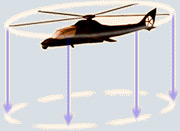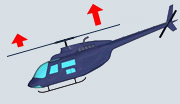|
The principles of aerodynamics that effect an airplane, a bird, a
rocket or a missile are the same that effect a helicopter.
Everything that flies encounters the same basic rules of lift, drag
and gravity.
 In order to fly, a helicopter uses different methods
than any other aircraft. Its rotors—its “wings” rotate in order to
produce lift. In a hover, it is this rotation that is the sole
producer of lift. In forward flight, however, the “rotating disk”
creating by the rotating individual blades produces additional lift. In order to fly, a helicopter uses different methods
than any other aircraft. Its rotors—its “wings” rotate in order to
produce lift. In a hover, it is this rotation that is the sole
producer of lift. In forward flight, however, the “rotating disk”
creating by the rotating individual blades produces additional lift.
The pilot controls the main rotor system by two controls, the cyclic
and the collective. The cyclic is the control directly in front of
the pilot, which he uses to the aircraft left or right, to bank left
or right, and to make the helicopter go forward or aft, It also is
used to make the aircraft stop or to stay in one place in the air,
or over a particular spot on the ground. The cyclic control performs
functions similar to what ailerons and elevators perform on an
airplane.
 The collective is found at the pilot’s left. The pilot
raises or lowers this control to make the aircraft climb or descend,
or to go faster or slower. Located on the collective is a
motorcycle-style throttle, which is usually controlled by a fuel
control. If not, when the pilot raises the collective to achieve
more aerodynamic power, he or she would have to simultaneously “roll
in throttle” by twisting the throttle one way as he or she raises
the collective and “roll out throttle” as he or she lowers the
collective. Otherwise, the rotor systems and the engine would
underspeed with the raising of the collective and overspeed with the
lowering of the collective. The collective can be thought of as a
power control. The collective is found at the pilot’s left. The pilot
raises or lowers this control to make the aircraft climb or descend,
or to go faster or slower. Located on the collective is a
motorcycle-style throttle, which is usually controlled by a fuel
control. If not, when the pilot raises the collective to achieve
more aerodynamic power, he or she would have to simultaneously “roll
in throttle” by twisting the throttle one way as he or she raises
the collective and “roll out throttle” as he or she lowers the
collective. Otherwise, the rotor systems and the engine would
underspeed with the raising of the collective and overspeed with the
lowering of the collective. The collective can be thought of as a
power control. The tail rotor at the rear of the aircraft enables
the pilot to control the direction of the nose of the aircraft, left
or right. In some helicopters, this rotor has been replaced by a
“fan,” and in other aircraft by highly pressurized air flow. The
function of this tail rotor is important at all times, but it is
most important in slow flight and hover operations. The pilot
controls the tail rotor by use of foot pedals. The tail rotor
performs the same function in a helicopter that the rudder performs
in an aircraft.
 Interestingly, the main rotor blades are
constantly changing their angle of attack, or “pitch,” as they
rotate. The input of both the cyclic and collective controls is
“blended together” at the main rotor, which allows the main rotor
blades not only to produce lift and speed but to also produce
directional flight and to hover. Interestingly, the main rotor blades are
constantly changing their angle of attack, or “pitch,” as they
rotate. The input of both the cyclic and collective controls is
“blended together” at the main rotor, which allows the main rotor
blades not only to produce lift and speed but to also produce
directional flight and to hover. Some helicopters still have
piston engines as their source of power, but most have turbine
engines. All helicopters have a device, called a transmission, or
“main gear box,” which changes the engine power into blade power. If
the helicopter has two engines, the power coming out of both engines
will be combined in a device called the combiner gear box before
reaching the main transmission. The main drive shaft, either
coming directly from the single engine or from the combiner gear box
in a multi-engine configuration, sends the power of the engine(s) to
the main transmission. From there power is carried to the main rotor
blades though the main rotor shaft, or the mast, and to the tail
rotor through the tail rotor drive shaft. On aircraft with two main
rotor systems, there are two main transmissions. To learn more
about how helicopters work, call our office, or visit
http://www.howstuffworks.com/helicopter.htm |